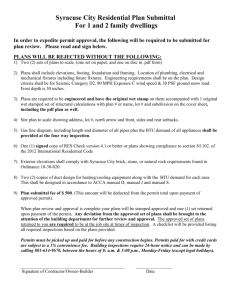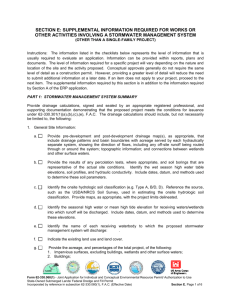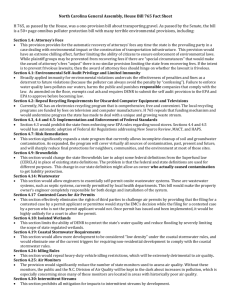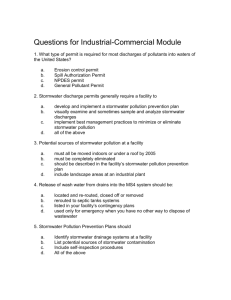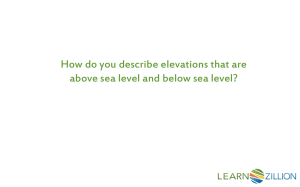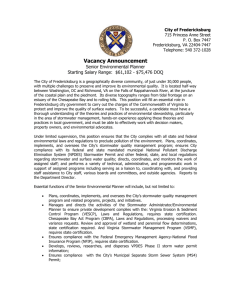62-330_060_sec_h_mines_... - St. Johns River Water Management
advertisement
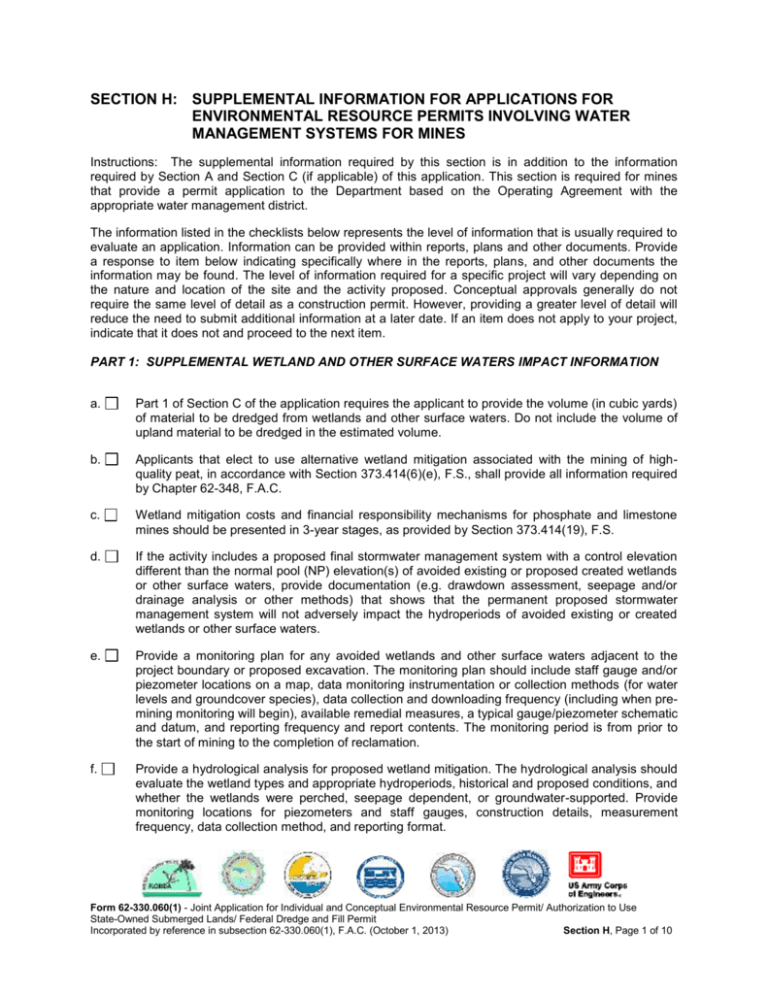
SECTION H: SUPPLEMENTAL INFORMATION FOR APPLICATIONS FOR ENVIRONMENTAL RESOURCE PERMITS INVOLVING WATER MANAGEMENT SYSTEMS FOR MINES Instructions: The supplemental information required by this section is in addition to the information required by Section A and Section C (if applicable) of this application. This section is required for mines that provide a permit application to the Department based on the Operating Agreement with the appropriate water management district. The information listed in the checklists below represents the level of information that is usually required to evaluate an application. Information can be provided within reports, plans and other documents. Provide a response to item below indicating specifically where in the reports, plans, and other documents the information may be found. The level of information required for a specific project will vary depending on the nature and location of the site and the activity proposed. Conceptual approvals generally do not require the same level of detail as a construction permit. However, providing a greater level of detail will reduce the need to submit additional information at a later date. If an item does not apply to your project, indicate that it does not and proceed to the next item. PART 1: SUPPLEMENTAL WETLAND AND OTHER SURFACE WATERS IMPACT INFORMATION a. Part 1 of Section C of the application requires the applicant to provide the volume (in cubic yards) of material to be dredged from wetlands and other surface waters. Do not include the volume of upland material to be dredged in the estimated volume. b. Applicants that elect to use alternative wetland mitigation associated with the mining of highquality peat, in accordance with Section 373.414(6)(e), F.S., shall provide all information required by Chapter 62-348, F.A.C. c. Wetland mitigation costs and financial responsibility mechanisms for phosphate and limestone mines should be presented in 3-year stages, as provided by Section 373.414(19), F.S. d. If the activity includes a proposed final stormwater management system with a control elevation different than the normal pool (NP) elevation(s) of avoided existing or proposed created wetlands or other surface waters, provide documentation (e.g. drawdown assessment, seepage and/or drainage analysis or other methods) that shows that the permanent proposed stormwater management system will not adversely impact the hydroperiods of avoided existing or created wetlands or other surface waters. e. Provide a monitoring plan for any avoided wetlands and other surface waters adjacent to the project boundary or proposed excavation. The monitoring plan should include staff gauge and/or piezometer locations on a map, data monitoring instrumentation or collection methods (for water levels and groundcover species), data collection and downloading frequency (including when premining monitoring will begin), available remedial measures, a typical gauge/piezometer schematic and datum, and reporting frequency and report contents. The monitoring period is from prior to the start of mining to the completion of reclamation. f. Provide a hydrological analysis for proposed wetland mitigation. The hydrological analysis should evaluate the wetland types and appropriate hydroperiods, historical and proposed conditions, and whether the wetlands were perched, seepage dependent, or groundwater-supported. Provide monitoring locations for piezometers and staff gauges, construction details, measurement frequency, data collection method, and reporting format. Form 62-330.060(1) - Joint Application for Individual and Conceptual Environmental Resource Permit/ Authorization to Use State-Owned Submerged Lands/ Federal Dredge and Fill Permit Incorporated by reference in subsection 62-330.060(1), F.A.C. (October 1, 2013) Section H, Page 1 of 10 PART 2: STORMWATER MANAGEMENT SYSTEM SUMMARY Provide drainage calculations, signed, sealed and dated by an appropriate registered professional, and supporting documentation demonstrating that the proposed project meets the conditions for issuance under Rules 62-330.301(1)(a), (b), (c), and (e), F.A.C. Larger mines or more complex mine plans may require one or more intermediate stage maps and drainage calculations to explain how the proposed water management system and offsite flows will change as mining and reclamation progress. The stormwater management system summary should include, but not necessarily be limited to, the following: 1. Site Information: a. Provide separate pre-development (existing), construction phase (during mining and reclamation) and post-development (post-reclamation) drainage maps, as appropriate, that include drainage patterns and basin/sub-basin boundaries. Provide the acreage for each basin/sub-basin and include flow direction arrows including any off-site runoff being routed through or around the system; topographic information; and connections between wetlands and other surface waters below the 25-year 24-hour design storm event. Merge the construction phase and postdevelopment elevation contours with the existing elevation contours in areas that will remain undisturbed. b. Where agricultural ditches are present, illustrate how the area hydrology will be altered due to the proposed project. Provide plan drawings that show the internal, perimeter, and surrounding agricultural ditches for the existing, construction, and post-reclamation phases. Clearly indicate whether the perimeter ditches are within or outside the project area. Flow direction arrows (include any seasonal flow reversals with an explanation of use, if applicable) and proposed alterations to the ditches should be shown in each drawing. Provide maps that clearly depict the progression of ditch severance as the stormwater management system expands. c. Provide the results of any percolation tests, where appropriate, and soil boring logs that are representative of the actual site conditions to the proposed excavation depth(s). Identify the wet season high water table elevations for the project area and hydraulic conductivity values. Include dates, datum, and methods used to determine these parameters. d. Identify the existing onsite hydrologic soil classifications (e.g. Type A, B/D, D). Reference the source, such as the U.S. Department of Agriculture/Natural Resource Conservation Service Soil Survey, used in estimating the onsite hydrologic soil classification. Provide maps, as appropriate, with the project limits delineated. e. Identify the seasonal high water or mean high tide elevation for receiving waters/wetlands into which runoff will be discharged. Include dates, datum, and methods used to determine these elevations. f. Indicate the existing and post-development land use and land cover. Provide the acreage, and percentages of the total project, of the following: Impervious surfaces (and directly connected impervious surfaces) excluding buildings, wetlands and other surface waters; Buildings; Pervious surfaces (green areas not including wetlands); Lakes, canals, retention areas, other open water areas; and Wetlands (Please refer to Section C to ensure consistency in wetland acreages). Form 62-330.060(1) - Joint Application for Individual and Conceptual Environmental Resource Permit/ Authorization to Use State-Owned Submerged Lands/ Federal Dredge and Fill Permit Incorporated by reference in subsection 62-330.060(1), F.A.C. (October 1, 2013) Section H, Page 2 of 10 g. Describe how the system will be operated and maintained for each stage throughout the life of the project. h. Identify the name and Waterbody Identification (WBID) number, if known, established for the Total Maximum Daily Load (TMDL) Program, of each receiving waterbody to which the proposed stormwater management system will discharge. i. Provide the location and description of any nearby existing offsite features (such as wetland and other surface waters, municipal well fields, large irrigation wells, stormwater management ponds, and building or other structures) which might be affected by or affect the proposed construction or development. 2. Water and Soil Quality Analysis: a. Provide a description of the proposed stormwater treatment methodology that addresses the type of treatment, pollution abatement volumes, and recovery analysis. Provide construction plans and calculations that address the required treatment volume and recovery, as well as stage-storage and design elevations, which demonstrate compliance with the appropriate water quality treatment criteria in the applicable Applicant’s Handbook, Vol. II. If a computer program is used for the analysis, provide the name of the program, a description of the program, input and output data, and justification for model selection. Based on the proposed activity and land use, water quality sampling may be required for surface water discharge from the project area. b. If the receiving waterbody is known to be impaired, and/or has an established Total Maximum Daily Load (TMDL) or Basin Management Action Plan (BMAP), provide specific descriptions of all water quality parameters for which the waterbody is known to be impaired. For more information about water quality, impaired waters, and to determine whether a TMDL has been adopted in your area, refer to: http://waterwebprod.dep.state.fl.us/basin411/downloads/FloridaAdoptedTMDLs.pdf. To determine whether a BMAP exists, or is being developed in your project area, refer to: http://www.dep.state.fl.us/water/watersheds/bmap.htm#rad. Provide calculations demonstrating that the proposed project will not contribute to violations of state water quality standards in accordance with the applicable Applicant’s Handbook, Vol. II. c. Identify public water supply wells within 500 feet of the proposed extraction area and private water supply wells located on properties that are immediately adjacent to the project boundary. Identify the wellfield cone of depression, if available, and source of information for public water supply wells. d. If the project will have a direct discharge to a Class I, Class II, Outstanding Florida Waters or Class III waters that are approved, conditionally approved, restricted, or conditionally restricted for shellfish harvesting, provide additional treatment in accordance with the applicable Applicant’s Handbook, Vol. II. To determine whether your project is within, or will discharge to an OFW, or for more information about OFWs in general, refer to: http://www.dep.state.fl.us/water/wqssp/ofw.htm. e. Provide a typical hydrostratigraphic column and/or representative hydrogeologic cross-sections for the proposed project site. Describe the hydrostratigraphic units and define all aquifer(s) and/or aquiclude(s) (semiconfining/confining beds) present at the project site. f. Contact the Department to discuss whether ambient surface water and groundwater quality characterization and compliance monitoring are necessary for the proposed project. If it is necessary, groundwater sampling will be required by depth intervals to at least the proposed Form 62-330.060(1) - Joint Application for Individual and Conceptual Environmental Resource Permit/ Authorization to Use State-Owned Submerged Lands/ Federal Dredge and Fill Permit Incorporated by reference in subsection 62-330.060(1), F.A.C. (October 1, 2013) Section H, Page 3 of 10 depth of extraction. It may be necessary to install permanent nested wells at different depths for compliance monitoring. If poorer water quality (e.g. for chloride, sulfates, total dissolved solids, etc.) is detected within a deeper portion of the aquifer than in the shallower part of the aquifer, extraction depth(s) may be limited. g. If the proposed project site is located in or near a karst-sensitive area, a springshed, a public supply wellfield or other karst features, submit a preliminary geotechnical assessment report. Provide information on how ambient water quality will be protected in groundwaters under the direct influence of surface waters during mining operations and under post-development conditions. Some karst-sensitive areas or springsheds may require a karst study be conducted for the proposed project site. Contact the Department to discuss a proposed study design. h. If the project will allow a reclaimed created lake to connect to offsite wetlands or other surface water during storms less than the 25-year, 24-hour design storm, or if the reclaimed lake will have more than one property owner, then the reclaimed lake will be “waters of the state” and must meet the water quality standards of Chapter 62-302, F.A.C. Describe how surface water quality standards will be met in waters of the state. If it is expected that the dissolved oxygen within the constructed surface water management system will not meet the water quality standard defined in Rule 62-302.530, F.A.C., then, a petition for variance may be provided per Sections 373.414(17) and 403.201(1), F.S. The format for the petition must follow the outline provided by Rule 62110.104(1), F.A.C. For the facts showing that a variance should be granted, describe how the project meets one or more of the reasons listed in Section 403.201(1), F.S. i. Identify the classification(s) (e.g. Class F-1, G-1, G-II, G-II and G-IV) of the groundwater in the project area and immediate vicinity according to the designated uses provided in Rule 62520.410, F.A.C. j. Provide the names, locations, and storage conditions for any chemicals that will be stored onsite. This includes all pH adjusters and water conditioners that may be used in the process water. Additionally, include how the chemicals will be utilized, e.g. blasting, vehicle maintenance, vegetation maintenance, and process water treatment. Identify on plans separate containment areas for equipment maintenance, and the storage of petroleum and hazardous substances that can prevent surface water from entering the mine pit to the standards specified in the Applicant’s Handbook. k. For previously mined (currently not in a construction phase of an ERP) lands, provide the lake depths of each existing lake. Identify areas of any existing lakes to be excavated deeper. Identify any onsite lake that has penetrated a confining layer between the water table aquifer and a lower aquifer. Include a discussion of the site-specific geology (including sand tailings and overburden deposition and orientation, if known) and aquifers and aquitards. l. Contact the Department to discuss whether soil sampling is necessary and if so, what parameters are required. Based on existing and previous land uses, an analysis of the soils may be required to identify chemical concentrations that exceed the Cleanup Target Levels (CTL) specified in Chapter 62-777, F.A.C. Land uses and analytes may include: Agricultural areas - ethylene dibromide, nitrates, nitrites, phosphorus, cadmium, pesticides, fungicides and herbicide residues in the surface soils of crop lands. Identify chemical storage areas, maintenance areas, and areas of strained vegetation on an aerial. Fuel storage and fueling areas - total recoverable petroleum hydrocarbon (TRPH) and related volatile organic compounds (e.g., BTEX); Cattle dip vats – arsenic and pesticides. Form 62-330.060(1) - Joint Application for Individual and Conceptual Environmental Resource Permit/ Authorization to Use State-Owned Submerged Lands/ Federal Dredge and Fill Permit Incorporated by reference in subsection 62-330.060(1), F.A.C. (October 1, 2013) Section H, Page 4 of 10 3. Water Quantity Analysis: a. Provide mine-wide drainage analyses of the pre-development and post-development peak rate of discharge, volume of runoff, and peak stages for the appropriate design storm events demonstrating that the project meets the applicable design criteria as indicated in the applicable Applicant’s Handbook, Vol. II. Account for all onsite depressional storage and offsite contributing area. Please refer to the applicable Applicant’s Handbook, Vol. II for the design storm event(s) that apply to your project. Typically, the information would include, at a minimum, but is not necessarily limited to, the following: Runoff characteristics, including area, runoff curve number or runoff coefficient, and time of concentration for each drainage basins in the pre-development and post-development condition; Design storms used including rainfall depth, duration, frequency, and distribution; Runoff hydrograph(s) for each drainage basin, for all required design storm event(s); Stage-storage computations for any area such as a reservoir, closed basin, detention area, or channel, used in storage routing; Stage-discharge computations for any storage areas at a selected control point, such as control structure or natural restriction; Flood routings through on-site conveyance and storage areas; Water surface profiles in the primary drainage system for each required design storm event(s); Runoff peak rates and volumes discharged from the site for each required design storm event(s); Design tailwater elevation(s) for each storm event at all points of discharge (include source or method of estimate); and Pump specifications and operating curves for range of possible operating conditions (if used in system). Provide a description of the engineering methodology, assumptions and references for the parameters listed above, and a copy of all such computations, engineering plans, and specifications used to analyze the system. Include basin-node-reach schematics and show the time of concentrations, flow conveyance structures, and Flow Comparison Points (Flow Evaluation Points or Critical Points) in the engineering plans. If a computer program is used for the analysis, provide the name of the program, input and output data, justification for model selection, and, if necessary, a description of the program. b. Provide sufficient freeboard in the stormwater management system to prevent the occurrence of overtopping. Provide the basis for determining the freeboard, such as staging the appropriate design storm event on the seasonal high water elevation (or control elevation) plus an effective freeboard. Perform a wave run up analysis, if necessary. c. Provide groundwater contour maps showing pre-development (existing), during mining and postdevelopment (post-reclamation) elevations extending at least 100 feet off the proposed project site. All elevations should be referenced to the common benchmark or datum (NGVD/NAVD) being utilized for the project site. Cite the date and data source for the existing condition. Identify if the contours represent average seasonal high water (SHW), normal pool (NP) or seasonal low water (SLW) table elevations. Note that it may be necessary to monitor groundwater elevations under pre-development, during mining and under post-development conditions to ensure no major changes occur due to mining. d. Changes in pre-development groundwater elevations on the proposed mining site may adversely impact the hydrology of onsite or offsite wetlands and other surface waters (including lakes, Form 62-330.060(1) - Joint Application for Individual and Conceptual Environmental Resource Permit/ Authorization to Use State-Owned Submerged Lands/ Federal Dredge and Fill Permit Incorporated by reference in subsection 62-330.060(1), F.A.C. (October 1, 2013) Section H, Page 5 of 10 streams, and spring discharges). Identify operational procedures and/or hydrologic measures which will be implemented to maintain the water elevations. Provide the following, as applicable: A water budget analysis for the existing, during mining, and post-reclamation conditions, as applicable. State the assumptions, scope of the water balance analyses, the source(s) of the data used in the calculation(s) and the name of the computer model, if applicable. A drawdown analysis supporting the use of a water elevation maintenance system. Include a cross section drawing of the hydration system, injection well, or recharge ditch in relation to features such as, the mine-cut face, cast overburden/seepage face, the ground surface, the overburden and matrix layers and the water table. e. If a dredge will be used, specify the approximate depth and area that will need to be excavated before the dredge will become operational. Describe the excavation method that will be used initially and the approximate length of time. If temporary dewatering will be conducted, please evaluate the projected drawdown of the water table in the preserved wetlands and provide this information. If necessary based on the results, provide protective measures, such as the construction of recharge ditches. f. If the project area is in the watershed of a first order stream (headwater), second order stream, etc., of a river where Minimum Flows and Levels (MFLs) have been established, provide a water quantity simulation representing the peak severance/dewatering conditions to demonstrate that the proposed activity will not contribute to violations of the established MFLs. 4. Floodplain Analysis (where applicable). a. Provide a Federal Emergency Management Agency (FEMA) flood map (include the project boundary on the map). b. If the project is in a known floodplain of a lake, stream or other water course, provide plan and cross-section figures showing the locations and elevations of the proposed berms and water control structures (to prevent erosion) that will allow offsite runoff to either enter the stormwater management system or be routed around the project area. Discuss these conditions for the during-mining and post-reclamation scenarios. c. For traversing works, in accordance with the applicable Applicant’s Handbook, Vol. II, provide: Hydraulic calculations for all proposed traversing works; and Water surface profiles showing upstream impact of traversing works. d. For impacts to regulated floodplains, in accordance with the applicable Applicant’s Handbook, Vol. II, provide: Location and volume of encroachment within regulated floodplain(s); and Plans and calculations for compensating floodplain storage, if necessary, and calculations required for determining minimum building and road flood elevations. PART 3: CONSTRUCTION PLANS Provide clear, construction level detailed plans for the system, including specifications, plan (overhead) views, cross section views (with the locations of cross section shown on the corresponding plan view) and profile (longitudinal) views of the proposed project. The plans must be signed, sealed, and dated by an appropriate registered professional. These plans should include cumulative information from all applicable sections of the application. Form 62-330.060(1) - Joint Application for Individual and Conceptual Environmental Resource Permit/ Authorization to Use State-Owned Submerged Lands/ Federal Dredge and Fill Permit Incorporated by reference in subsection 62-330.060(1), F.A.C. (October 1, 2013) Section H, Page 6 of 10 a. Provide the project boundary and total acreage, including distances and orientation from roads or other landmarks on a recent aerial legible for photo interpretation with a scale of 1 inch = 400 feet, or more detailed. Include the date of the photo. The project boundary should not include the portions of the property that will not be altered or disturbed by permitted activities. Include surface areas where there will be construction, alteration, operation, maintenance or repair, abandonment, or removal of any stormwater management system, dam, impoundment, reservoir, work (including dredging or filling), or appurtenant work. This would also include wetland mitigation areas. b. On each plan sheet, include a scale and scale bar. Include the county name, Section, Township, and Range, and a north arrow on each plan view. c. Provide individual plans for the existing, during–mining (and intermediate stages, if necessary), and post-reclamation conditions. Include the following: Topography extending at least 100 feet off the project area shown on a recent aerial map. All topography shall include location and description of benchmarks referenced to NGVD 1929 or NAVD 1988 along with the conversion factor. Match the contours within with the undisturbed contours. US Geological Survey topographic map for comparison. Land use and land cover (acreage), and on-site natural communities, including wetlands and other surface waters, aquatic communities, and uplands. Use the Florida Land Use Cover and Classification System (FLUCCS) (Level 3). Also identify each community with a unique identification number which must be consistent in all exhibits. Wetlands and other surface waters to be impacted or avoided and mitigation areas. Undisturbed upland buffers adjacent to wetlands and other surface waters. Areas to be excavated, the proposed mine cells and sequence of mining or excavation. Staging/temporary overburden storage areas, product stockpiles areas, processing areas, and waste disposal areas (e.g. disposal areas for humate, clays, and tailings). Utility, pipeline, equipment, dredge and dragline crossings and corridors. Distinguish between temporary (single use) and long-term crossings and corridors. Provide an estimated time schedule for construction and removal of each crossing or corridor. Impervious surfaces (including directly connected impervious surfaces), vehicle parking areas and haul roads including stormwater management systems for these areas. Internal and external perimeter berms. Recirculation ditches, recharge ditches, stormwater ditches. Connections/outfalls to wetlands or other surface waters. Normal mine operation water elevation, and the seasonal high and low water elevations. All water management structures, volumes and invert elevations. Where the proposed water management system for a mine will partially replace an existing surface water management system, provide drainage plans and reports showing how the system outside of the mine will function as mining and reclamation proceed. For phased projects where each phase is a stand-alone system, provide a master development plan clearly delineating the limits of each phase of construction. Applicants should be aware that a Conceptual Reclamation Plan, or a Notice of Intent to Mine may be required by the Department in accordance with Chapter 378, F.S., prior to the start of mining operations. The plan for the proposed (post reclamation) conditions should meet the requirements of the appropriate reclamation rules. Form 62-330.060(1) - Joint Application for Individual and Conceptual Environmental Resource Permit/ Authorization to Use State-Owned Submerged Lands/ Federal Dredge and Fill Permit Incorporated by reference in subsection 62-330.060(1), F.A.C. (October 1, 2013) Section H, Page 7 of 10 d. Paving, Grading, and Drainage Information for the existing, during-mining (and intermediate stages, if necessary), and post-reclamation conditions, which includes, but not necessarily limited to, the following: Plan view of proposed development, including processing area and water quality treatment areas. Proposed elevations and/or profiles. Roadway, parking, and pavement grades. Floor slabs, walkways, and other paved surfaces. Earthwork grades for pervious landscaped areas. Perimeter site grading, tying back into existing grades. Location of all water management areas, including elevations, dimensions, side slopes, and design water depths. Location, size, and invert elevations of existing and proposed stormwater conveyance systems. Vegetative cover plan for all on-site and off-site earth surfaces disturbed by construction. Rights-of-way and easements for the system, including all on-site and off-site areas to be reserved for water management purposes (including access), and rights-of-way and easements for the existing drainage system, if any. e. Provide the geometric characteristics of each disposal area, including the average dike height (feet), dike crest elevation, maximum operating water level, crest width (feet), outside and inside slopes (below and above grade), effective area (acres), effective depth (feet), effective pit bottom depth below grade(feet) and effective storage volume (acre-feet). f. Stormwater detail information, including but not necessarily limited to, the following: Cross section of all stormwater management areas, including elevations, dimensions, crest widths, side slopes, and proposed stabilization measures (with location of the cross section(s) shown on the corresponding plan view). Provision for permanent stabilization of the slopes through the establishment of permanent vegetative cover or other appropriate methods. Detail of all proposed control structures, including elevations, dimensions, and skimmer, where applicable. Details of proposed stormwater management systems, such as underdrains, exfiltration trenches, vaults, and other proposed Best Management Practices (BMPs). g. Provide a cross sectional view of the reclamation lake(s); show the lake configuration, including side slopes and grade-break, elevations for the shoreline, lake bottom elevation, the average (normal pool), seasonal high, and seasonal low water elevations, littoral zone, and associated control structures. h. For limestone mines, provide a cross-sectional view of reclaimed sheer walls. Provide a plan view showing the location and extent of areas to be reclaimed with sheer walls. For fuller’s earth and other resources (gravel, sand, clay) mines provide a cross-sectional view of reclaimed high walls. Provide a plan view showing the location and extent of areas to be reclaimed with high walls. Refer to Rules 62C-38.008 or 62C-39.008, F.A.C., for limits on steepness of slopes. Provide the appropriate geotechnical engineering study if slopes will be steeper than the limits provided by rule. PART 4: CONSTRUCTION SCHEDULE AND TECHNIQUES Provide a construction schedule, and a description of construction techniques, sequencing and equipment. This information should include, as applicable, the following. Form 62-330.060(1) - Joint Application for Individual and Conceptual Environmental Resource Permit/ Authorization to Use State-Owned Submerged Lands/ Federal Dredge and Fill Permit Incorporated by reference in subsection 62-330.060(1), F.A.C. (October 1, 2013) Section H, Page 8 of 10 a. Access and staging of equipment. b. Location and details of the erosion, sediment and turbidity control measures to be implemented during each phase of construction and all permanent control measures to be implemented in post-development conditions. c. The location of disposal site(s) for any excavated material, including temporary and permanent disposal sites. d. A demolition plan for any existing structures to be removed. e. Dewatering plan details. Provide the dewatering location(s), methods to contain the discharge, methods of isolating dewatering areas, the period dewatering structures will be in place, and the hydrologic monitoring plan. Note: a Consumptive Use or Water Use permit may be required for dewatering. f. Methods for transporting equipment and materials to and from the work site. If barges are required for access, provide the low water depths and draft of the fully loaded barge. g. Describe the measures that will be taken to protect and secure any monitoring wells, piezometers and staff gauges from mining and reclamation activities so that they will be available for water quality and quantity sampling. Also, describe how the monitoring equipment will be surveyed and if the elevations will be intermittently confirmed. h. Identify the schedules and parties responsible for completing hydrologic and vegetative monitoring, and record drawings and as-built certifications for the project when completed. i. Provide a detailed Stormwater Pollution Prevention Plan (SWPPP) that includes Best Management Practices to control erosion, sediment, and turbidity. The plan should identify the construction activities for the proposed project; address the control measures for the preconstruction (e.g., land preparation) and construction phases (mining), and all permanent control measures to be implemented in post–development (reclamation) conditions. Show the locations of staff gauges/piezometers and erosion, sediment, and turbidity controls, direction of storm water runoff and other details, as appropriate. j. Provide projected production and disposal schedule for waste materials, such as clay, humate, tailings, by year and location. Provide total storage capacity for each disposal location and the remaining capacity (if it is an existing disposal location). k. Provide a production and utilization schedule for the backfill materials to demonstrate that there is sufficient backfill material available to construct the proposed post-reclamation elevations. PART 5: OPERATION AND MAINTENANCE AND LEGAL DOCUMENTATION: a. Describe the overall maintenance and operation schedule for the proposed system. b. Identify the entity (or entities) that will be responsible for operating and maintaining the system (or parts of the system) to demonstrate that the entity (or entities) meet(s) the requirements of Section 12.3 of the Applicant’s Handbook, Vol. I. c. If different from the permittee, provide a draft document enumerating the enforceable affirmative obligations on the entity to properly operate and maintain the system for its expected life, and documentation of the entity's financial responsibility for long-term maintenance. Form 62-330.060(1) - Joint Application for Individual and Conceptual Environmental Resource Permit/ Authorization to Use State-Owned Submerged Lands/ Federal Dredge and Fill Permit Incorporated by reference in subsection 62-330.060(1), F.A.C. (October 1, 2013) Section H, Page 9 of 10 d. If the proposed operation and maintenance entity is not a property owner's association, provide proof of the existence of an entity, or the future acceptance of the system by an entity which will operate and maintain the system. e. Provide drafts of all proposed conservation easements, stormwater management system easements, draft property owner's association documents, and plats for the property containing the proposed system. f. Provide legal reservations for access to the treatment system for maintenance and operation by future maintenance entities for subdivided projects. g. Provide indication of how water and wastewater service will be supplied. h. Provide a copy of the boundary survey and/or legal description and acreage of the total land area of contiguous property owned/controlled the applicant. PART 6: WATER USE a. Describe how irrigation will be provided to the project. Identify if the surface water system that will be used for water supply, including landscape irrigation, or recreation. b. If a Consumptive Use or Water Use permit has been issued for the project, state the permit number: c. If a Consumptive Use or Water Use permit has not been issued for the project, indicate if such a permit will be required and when the application will be submitted. d. Indicate how any existing water use wells located within the project site will be utilized or abandoned. PART 7: SPECIAL BASIN INFORMATION Is your project within a special basin as described in the applicable Applicant’s Handbook, Vol. II? yes no don’t know If yes, please demonstrate that the project will meet the applicable special basin criteria. Form 62-330.060(1) - Joint Application for Individual and Conceptual Environmental Resource Permit/ Authorization to Use State-Owned Submerged Lands/ Federal Dredge and Fill Permit Incorporated by reference in subsection 62-330.060(1), F.A.C. (October 1, 2013) Section H, Page 10 of 10
